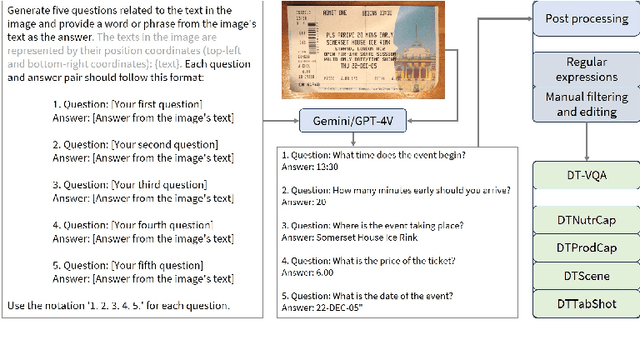Zhiyin Ma
MonkeyOCR: Document Parsing with a Structure-Recognition-Relation Triplet Paradigm
Jun 05, 2025Abstract:We introduce MonkeyOCR, a vision-language model for document parsing that advances the state of the art by leveraging a Structure-Recognition-Relation (SRR) triplet paradigm. This design simplifies what would otherwise be a complex multi-tool pipeline (as in MinerU's modular approach) and avoids the inefficiencies of processing full pages with giant end-to-end models (e.g., large multimodal LLMs like Qwen-VL). In SRR, document parsing is abstracted into three fundamental questions - "Where is it?" (structure), "What is it?" (recognition), and "How is it organized?" (relation) - corresponding to layout analysis, content identification, and logical ordering. This focused decomposition balances accuracy and speed: it enables efficient, scalable processing without sacrificing precision. To train and evaluate this approach, we introduce the MonkeyDoc (the most comprehensive document parsing dataset to date), with 3.9 million instances spanning over ten document types in both Chinese and English. Experiments show that MonkeyOCR outperforms MinerU by an average of 5.1%, with particularly notable improvements on challenging content such as formulas (+15.0%) and tables (+8.6%). Remarkably, our 3B-parameter model surpasses much larger and top-performing models, including Qwen2.5-VL (72B) and Gemini 2.5 Pro, achieving state-of-the-art average performance on English document parsing tasks. In addition, MonkeyOCR processes multi-page documents significantly faster (0.84 pages per second compared to 0.65 for MinerU and 0.12 for Qwen2.5-VL-7B). The 3B model can be efficiently deployed for inference on a single NVIDIA 3090 GPU. Code and models will be released at https://github.com/Yuliang-Liu/MonkeyOCR.
FlameGS: Reconstruct flame light field via Gaussian Splatting
Dec 24, 2024



Abstract:To address the time-consuming and computationally intensive issues of traditional ART algorithms for flame combustion diagnosis, inspired by flame simulation technology, we propose a novel representation method for flames. By modeling the luminous process of flames and utilizing 2D projection images for supervision, our experimental validation shows that this model achieves an average structural similarity index of 0.96 between actual images and predicted 2D projections, along with a Peak Signal-to-Noise Ratio of 39.05. Additionally, it saves approximately 34 times the computation time and about 10 times the memory compared to traditional algorithms.
Exploring the Capabilities of Large Multimodal Models on Dense Text
May 09, 2024



Abstract:While large multi-modal models (LMM) have shown notable progress in multi-modal tasks, their capabilities in tasks involving dense textual content remains to be fully explored. Dense text, which carries important information, is often found in documents, tables, and product descriptions. Understanding dense text enables us to obtain more accurate information, assisting in making better decisions. To further explore the capabilities of LMM in complex text tasks, we propose the DT-VQA dataset, with 170k question-answer pairs. In this paper, we conduct a comprehensive evaluation of GPT4V, Gemini, and various open-source LMMs on our dataset, revealing their strengths and weaknesses. Furthermore, we evaluate the effectiveness of two strategies for LMM: prompt engineering and downstream fine-tuning. We find that even with automatically labeled training datasets, significant improvements in model performance can be achieved. We hope that this research will promote the study of LMM in dense text tasks. Code will be released at https://github.com/Yuliang-Liu/MultimodalOCR.
TextMonkey: An OCR-Free Large Multimodal Model for Understanding Document
Mar 15, 2024Abstract:We present TextMonkey, a large multimodal model (LMM) tailored for text-centric tasks. Our approach introduces enhancement across several dimensions: By adopting Shifted Window Attention with zero-initialization, we achieve cross-window connectivity at higher input resolutions and stabilize early training; We hypothesize that images may contain redundant tokens, and by using similarity to filter out significant tokens, we can not only streamline the token length but also enhance the model's performance. Moreover, by expanding our model's capabilities to encompass text spotting and grounding, and incorporating positional information into responses, we enhance interpretability. It also learns to perform screenshot tasks through finetuning. Evaluation on 12 benchmarks shows notable improvements: 5.2% in Scene Text-Centric tasks (including STVQA, TextVQA, and OCRVQA), 6.9% in Document-Oriented tasks (such as DocVQA, InfoVQA, ChartVQA, DeepForm, Kleister Charity, and WikiTableQuestions), and 2.8% in Key Information Extraction tasks (comprising FUNSD, SROIE, and POIE). It outperforms in scene text spotting with a 10.9\% increase and sets a new standard on OCRBench, a comprehensive benchmark consisting of 29 OCR-related assessments, with a score of 561, surpassing previous open-sourced large multimodal models for document understanding. Code will be released at https://github.com/Yuliang-Liu/Monkey.
Monkey: Image Resolution and Text Label Are Important Things for Large Multi-modal Models
Nov 24, 2023



Abstract:Large Multimodal Models (LMMs) have shown promise in vision-language tasks but struggle with high-resolution input and detailed scene understanding. Addressing these challenges, we introduce Monkey to enhance LMM capabilities. Firstly, Monkey processes input images by dividing them into uniform patches, each matching the size (e.g., 448x448) used in the original training of the well-trained vision encoder. Equipped with individual adapter for each patch, Monkey can handle higher resolutions up to 1344x896 pixels, enabling the detailed capture of complex visual information. Secondly, it employs a multi-level description generation method, enriching the context for scene-object associations. This two-part strategy ensures more effective learning from generated data: the higher resolution allows for a more detailed capture of visuals, which in turn enhances the effectiveness of comprehensive descriptions. Extensive ablative results validate the effectiveness of our designs. Additionally, experiments on 18 datasets further demonstrate that Monkey surpasses existing LMMs in many tasks like Image Captioning and various Visual Question Answering formats. Specially, in qualitative tests focused on dense text question answering, Monkey has exhibited encouraging results compared with GPT4V. Code is available at https://github.com/Yuliang-Liu/Monkey.
 Add to Chrome
Add to Chrome Add to Firefox
Add to Firefox Add to Edge
Add to Edge